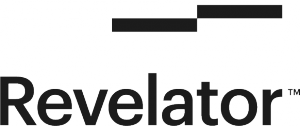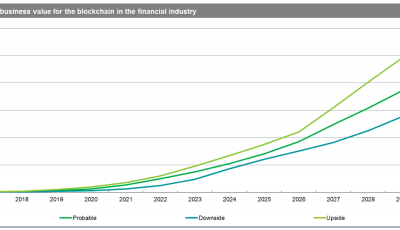Blockchain technology’s potential making waves in music industry
In July, the Berklee Institute for Creative Entrepreneurship (BerkleeICE) released a report focused on promoting fairness and transparency in the music industry.
The report’s recommendations included the creation of a decentralized, feasible rights database, and the investigation of blockchain technology and digital currencies to manage and track online payments through the value chain directly to music creators from fans.
Since the report’s release, news has surfaced about startups leveraging blockchain technology to disrupt the music industry.
In an article published August 5, Billboard magazine profiled PeerTracks, which plans to use blockchain technology to develop a kind of artist equity trading system, and Ujo, which is creating a system designed to address two key issues in global royalty distribution and licensing.
PeerTracks president Cédric Cobban explained to Billboard that his company is a “music streaming and music retail platform that allows for fan engagement and peer-to-peer talent discovery.” Slated to launch this fall, PeerTracks will use the blockchain for its transactions, distributing streaming revenue on a per-user-share basis, meaning that the revenue each user generates will go directly to the artists to whom users are actually listening.
Aiming to stay ad-free for users, PeerTracks hopes to generate marketing dollars through “artist tokens,” reported Billboard. Every artist on PeerTracks can build their own token featuring their name and face. The artist sets the amount of tokens available. “Since it is limited edition,” said Cobban to the magazine, “once you create tokens, you can’t create more.” The goal is to build a kind of sub-cryptocurrency, whose valuation directly reflects an artist’s appeal.
Billboard reported that PeerTracks tokens’ valuation is determined by supply and demand. Tastemakers can purchase tokens from unknown artists while they are cheap, speculating on that artist’s future potential.
“Boom! Your incentives have been magically aligned with that of the artist,” explained Cobban to the magazine. “You now want that artist discovered, you want him to sell music. You want him to be streamed and sell merchandise, because your tokens can go up in value as that artist becomes more successful.”
Cobban added, “Some users might not be interested in combing through newly uploaded content”; instead, they’ll chose to listen to what’s rising.
Artists using PeerTracks will themselves be able to influence their tokens’ value through a buy-back program, using revenue generated from tickets, streams or merchandise on the platform to buy back their own tokens (boosting demand) and destroying what was bought back (dropping supply). Billboard said the higher demand and lower supply means that, all else being equal, the token’s worth shoots up, as would the artist’s profile on the platform. Artists’ offers to fans such as complimentary tickets or discounts could also influence demand. The magazine said such rewards encourage fans to collect tokens from their favorite artists, also increasing the token’s value. These rewards are meant to attract advertisers to pay PeerTracks for the right to sponsor more renowned artists with products they can give away to fans. The plan is to use those ad dollars to cover streaming royalties.
Eddie Corral, PeerTracks’ CEO, told Billboard that “every single song uploaded will be attached to a smart contract. And that smart contract divides up the funds depending on the actual real-life contract: this is the lyricist, this is the composer, this is the performer. It’s all divided up automatically.”
For Ujo, the mission is to develop a rights database and payment infrastructure upon which anyone can use and build applications for free. “Our view is that there is no advantage in multiple people all building the same infrastructure – it should be shared and open,” said Phil Barry, a proponent of the project, to Billboard.
Barry, who worked as a consultant on Radiohead singer Thom Yorke’s BitTorrent-released album Tomrrow’s Modern Boxes last year, is working with a group of about 20 technologists based in Europe, New York and South Africa on the Ujo platform.
The initiative is striving to tackle two key problems: how money is distributed to artists and rights holders, and determining the ownership of a creative work, a convoluted structure in which songs can have multiple co-writers. The latter issue makes licensing difficult. “We in the music industry should be doing everything possible to make it easy for people to license music,” said Barry, “because that is when you get new business models and new revenue opportunities that might benefit the music industry in the future.”
Billboard noted that the industry’s last attempt at cataloging songs and their creators, the Global Repertoire Database, was unsuccessful. Getting the music industry at large to embrace the blockchain will take a long time. “People have their own vested interests in keeping data private, and all the existing systems are outdate and don’t match up,” said Barry to the magazine. “[But] if we wait for all the music publishers and all the collecting societies and everybody to organize themselves, sit around a table and reach an agreement about creating this central database we’ll be waiting until the end of the next century.”
Barry said he hopes Ujo will, bit by bit, replace those outdated systems, saving the music industry money; generating new revenue, business and licensing models and changing the way people consume music.
Billboard reported that in the future if an artist creates a song, it is eternally stored on the blockchain through a unique ID. The slightest change to that song would result in a new ID, so remixes, for example, would be instantly recognizable. Revenue will not end up in one big pot as a flat-charge to be paid out pro-rata, but rather distributed immediately and proportionately to each rights holders.
The magazine said Ujo will provide artists with tools for negotiation and voting, so the artists can set limits on how their creations are used.
“Just standing in the middle, collecting money, waiting a year, sending it on and taking 10 percent won’t work anymore,” said Barry to Billboard. “If anybody wants to build a new curation or streaming service, a negotiating service or other things that no one has imagined yet they can just build it on top of the blockchain. If it is a good model that benefits the creative community it will succeed, if not, it won’t.”
 On August 12, Colu, a blockchain technology service, announced the official launch of its beta platform, where anyone can create a layer of digital assets on top of the Internet using the blockchain.
On August 12, Colu, a blockchain technology service, announced the official launch of its beta platform, where anyone can create a layer of digital assets on top of the Internet using the blockchain.
 The company also announced its first integration with Revelator, a cloud-based provider of sales, marketing and intelligence for music businesses.
The company also announced its first integration with Revelator, a cloud-based provider of sales, marketing and intelligence for music businesses.
“The music industry is one of the domains who took the most dramatic hits when it comes to stepping into the digital era, mainly because of the challenges of preventing intellectual property from being copied freely – aka Digital Rights Management,” said Colu in a blog post. “That’s why, it’s only natural the solution would come from a digital evolution – and this is where blockchain technology comes into the picture.”
Like PeerTracks and Ujo, Colu pointed out the problems that plague the music industry with respect to rights, licensing, transparency and business models. The company said it is collaborating with Revelator to create a Rights Management API, which would provide the secure issuance and distribution of digital rights, including listing and registering musical works and providing more transparency to all market participants.
“We are very excited about the potential for Colu’s platform to simplify the management of music rights, starting with those associated with songwriters and their compositions,” said Bruno Guez, founder and CEO of Revelator, in a Colu press release. “Colu has made the complex technology of the blockchain accessible for integrations into platforms like ours, and we’re looking forward to exploring all the ways it can improve service to our clients.”
Musician and investor D.A. Wallach, who outlined blockchain’s potential in the music industry in an essay called “Bitcoin for Rockstars,” praised the partnership between Colu and Revelator, stating in the press release that “I am thrilled that such capable entrepreneurs are chipping away at the vexing lack of transparency that makes it so hard for artists today to understand their sources of income. There is great opportunity for this approach to evolve into an industry-wide standard.”
One initiative similar to PeerTracks is called ArtByte (formerly AppleByte), a peer-to-peer platform using digital currency technology to support artists, be they musicians, actors, dancers, directors, photographers, painters and more.
ArtByte’s mission is to support artists worldwide as they build their careers with a specialized digital currency called artbytes, which artists can receive and spend for financial support and to increase their exposure.
According to ArtByte’s website, artists can obtain artbytes in three ways: from fans who wish to support them, by putting more coins into circulation, and by mining them.
ArtByte users can access artbytes through a mobile and online wallet and earn free tokens by picking them from the ArtByte Orchard. Aside from tipping artists via Twitter, artbytes can be used to purchase music. Individuals can mine the tokens with the wallet app, buy them on the Poloniex and Bittrex exchanges or buy them from the ArtByte Foundation with a credit card.
The ArtByte Foundation helps artists gain more exposure by sharing social media content about participating artists on Facebook and Twitter. Interested artists can apply to be listed on the foundation’s website for further promotion. ArtByte also has a dedicated forum where artists can share links to their creations and generate a fan base.
Meanwhile, as such platforms emerge, musicians are turning to the blockchain on which to release their works or to develop their own platforms to disrupt the music industry.
At an event in London in late September that will bring together artists and technology developers, British musician Imogen Heap plans to release a new single, via a live performance, on the blockchain.
In an interview with International Business Times (IBTimes), Heap, who is a staunch supporter of distributed ledgers, discussed her Mycelia project to distribute and connect music. On the first day of the event, she will release her new single, “Tiny Human,” by way of a recorded live performance, after which it will be “available for the various platforms and databases to hack away and show us what they can do.”
In the next 24 hours, said Heap, “we see what’s happened to the song and its metadata. I think seeing lots of platforms all together will really open up some very lively debate and hopefully push things forward.”
What Heap would like to see is the music industry “turning onto its feet,” putting the music and its creators at the head of the food chain.
“A fair trade for music is desperately needed. Transparency. Cut out the middlemen. The tech is here and everyone’s talking about it,” said Heap to IBTimes. “We have reached a tipping point it feels and we are going to see many platforms rising from the soon to be ashes of the industry as we know it. This desperately needs to happen to sustain music makers of the future.”
Heap is considering a number of technologies such as audiocoin, the Alexandria Project and other Bitcoin 2.0 systems.
She told IBTimes that so far she has “seen lots of interesting platforms and tools, but nothing is really that integrated.”
Heap added, “We need to define protocols, with artists, so we can build these places like lego onto a global database. A grand library treasured and nurtured. Not owned by one company but by everyone who uses it.”
In her interview with IBTimes, Heap described her Mycelia project as “the grand library of all music” in which a piece of music (known as a spore) is uploaded and verified by the artist, marking the splits and connecting all metadata to that song, such as the instruments used and where the lyrics were written.
Heap said movement of that spore credits the creators’ digital wallets. Services (called mushrooms) use the music/files/data and the artist pays them a percentage for that service. “Those which are useful…open, dynamic will grow stronger and those which are taxing, closed and clunky wither and die…as they do in nature,” said Heap.
She added that in Mycelia, “everything interconnects and feeds back. Empowering the artist and the listener to create and discover in currently impossible ways.”
In a recent conversation with Forbes contributor George Howard, Heap said Mycelia’s existence would be thanks to individuals who host and update the network of spores. Those people would be rewarded for their work to verify the platform and maintain the integrity of its data, through the distribution of a transaction fee and perks from artists.
Heap said that on Mycelia, all decisions will be made collectively by a vote from content creators. A spore may be updated by an “unofficial source,” which could have preferences switched on or off by those engaging with the spore to demonstrate whether it is official material from the content creator or fan-added.
Heap told Howard the Mycelia is not exclusive to music, encompassing all creative media. Aside from money, an artist can also earn a reputation on Mycelia, having their creativity or social media research rated. The ratings would join wherever the artist’s content is accessed, either directly from the Mycelia library or one of the mushrooms.
“Simply put, no matter who you are, if your data is being used, you’ll be acknowledged by Mycelia’s ratings and/or paid for it,” said Heap. “So, if you are high up in efficiency and trustworthiness, but don’t have that much of a social reach yet, you may be cheaper than a Pro with a following, but you can still get started.”
Another artist who has embraced transparency around her music is Canadian-born cellist and composer Zoë Keating, whom Howard, the Forbes contributor, interviewed for an article published in June.
Keating was among the invited attendees to the Blockchain Summit held at Richard Branson’s Necker Island (this YouTube video about the summit features Keating’s music).
Asked to describe her experience at the summit, Keating said:
“My fly-on-the-wall impression was of a passionately engaged group of people – entrepreneurs, investors and thinkers – brought together to explore the potential of the blockchain for the betterment of the world…I certainly picked the brains of everyone who would tolerate me and the topics were broad. Everything from encoding personal identity and property rights into the blockchain to making elections transparent.”
A believer “in transparency in everything,” Keating publicly posts her royalty statements from digital streaming. She told Howard she initially did so “because the dominant story in the press on artist earnings did not reflect my reality, nor that of musical friends I talked to. None of us were concerned about file sharing/piracy, we seemed to sell plenty of music directly to listeners via pay-what-you-want services while at the same time earn very little from streaming.”
Having avoided working with record labels throughout her career, Keating added, “Since artists under record contracts might be prohibited from publishing their earnings, or might not even know them, I felt obliged to raise my hand and describe my reality. I thought, how can we build a future ecosystem without knowing how the current one actually works?”
Keating went on to say she’s interested in using blockchain technology to track derivative works. “What if you could know the actual reach of something? It seems like there are entire ecosystems not being leveraged or monetized.”
With similarities to Heap’s vision for Mycelia, Keating told Howard, “If there was a distributed ledger of music metadata, it could keep track not only who created what, but who else was materially involved, from the producer, to the side musicians, to the people who promote it, to the samples taken from another song.” She acknowledged Heap’s efforts later in the interview.
Another musician who has delved into the blockchain realm is hip-hop and rap artist Toby Ganger, who produced a song called “Welcome to the Blockchain (The Bitcoin Song).”
In a recent interview with SiliconANGLE, Ganger said he first learned about Bitcoin in early summer 2012 from a friend, then spent a couple of weeks absorbing as much information about the digital currency as he could.
Ganger said when it comes to music, Bitcoin opens new possibilities for marketing, sales and distribution.
“One could conceivably sell or distribute shares in their songs to fans or collaborators, keep records of it in the blockchain, and create a system that distributes a percentage of profits automatically to all those with a percentage of ownership without any of the middle men or accounting concerns.”
He added, “Also, as music tends to be consumed today on a song to song basis instead of whole albums, it’s better to make a 99 cent sale without having 30 percent come out in fees just to process the transaction via credit card/paypal/distributor. We may very well be looking at a completely different paradigm in both politics and music over the next 10-15 years due to this technology.”
Ganger told SiliconANGLE that he’d encourage anyone to at least explore Bitcoin technology and consider the implications of it toward their own lives, views and industries. “It will have different meaning and relevance to different people but I think it’s hard to spend time exploring this new technology without coming away with some new way to approach things.”
Referencing the BerkleeICE report in a recent article, Music Ally – a London-based music industry consultancy – sought opinions on whether digital currencies and distributed ledgers would really have an impact on music.
Gregor Pryor, a London-based partner at Reed Smith and co-chair of the law firm’s international Entertainment and Media Industry Group, has some reservations, noting that for the type of solution proposed in the BerkleeICE report to be realized, it would first require a widespread adoption of Bitcoin or a similar digital currency. Also, it relies on the ability of music rights holders to develop an international, unified database of music rights, which the failed Global Repertoire Database tried to do.
“It became a huge white elephant, because the industry among the publishers couldn’t agree on some pretty basic things,” said Pryor to Music Ally. “The other comparable example is DDEX [the consortium trying to create digital supply-chain standards in the music market]. If you think about how long both those have taken to put together, you see the challenge.”
Pryor believes labels will have trouble trying to creating a unique ID for many songs – especially those distributed in several versions worldwide – particularly for independent labels, which may have numerous distribution deals in place for different markets.
“I would distil that problem into saying that it’s a rights management problem. So you’ve got a data problem, an adoption problem, and a rights management problem, when you start looking at this in more detail, even though it [initially] seems like the holy grail… And that’s before you think about the majority of music revenues coming from broadcast and performance, not digital,” said Pryor.
He said blockchain is “a nice soundbite, and it’s right to explore it and consider it. But as it stands, rather than a blockchain, it’s more a pipedream actually,” though Pryor welcomes the debate. “The transparency that everyone’s really calling for is what are the deals between the big digital services and the rightsholders? And the blockchain thing is instructive, because it requires you to look at the way the money flows.”
Speaking with Music Ally, PledgeMusic president and founder Benji Rogers said the notion of a distributed ledger database is “going to radically change quickly the way in which payments are made, and the music industry won’t really have a choice. The content industries won’t have a choice: it’s going to be a fact: all of a sudden, it will be possible to pay out hundreds of millions and billions of micro-transactions.”
Although he acknowledged the technical and business obstacles in the way of a blockchain-based system being used for music payments, Rogers warned against drawing negative conclusions from the current market.
“The questions about the limitations are the equivalent of asking pre-Google ‘what will search look like?’ or pre-Chrome or Safari ‘what will the web look like?’. It’s like looking at Netscape Navigator in 1995 and trying to imagine Facebook in 2015,” said Rogers to Music Ally.
Rogers would like the music industry to consider blockchain technology as the driver for new types of digital music services that would break out from the flat-monthly-fee, all-access mold seen in the current streaming market, something he believes will depend on new music formats that have the micro-transaction payment systems built into them.
“It produces a way of creating low-cost, low-barrier-to-entry music services for dissemination and consumption, based on what the listener wants, as opposed to the standard ‘it’s £9.99 and you have to have it all’ approach,” said Rogers to Music Ally. “That’s where the potential is staggering: consume what you want, and in the quantity that you want. The music industry has reached its maximum point of disruption, with revenues having fallen drastically over the last 15 years. I think this technology has arrived just in time.”
In a recent post for The Trichordist, a community blog for artists advocating for an ethical and sustainable Internet, Alan Graham aired his concerns regarding the hype of blockchain technology to solve problems in the music industry
A co-founder of OCL, described as “a technological and philosophical bridge for building connections between technology platforms, rights owners, and citizens,” Graham wrote that his current concern with the rush to invest or get involved in blockchain projects is the fact that when investors dive into new technology, it often gets twisted from its original mission into something completely different.
“What made bitcoin and blockchain so attractive to many developers and users was that it wasn’t part of ‘the system’, nor built around the idea of being part of the establishment. And yet, that is exactly what is happening,” said Graham.
He wrote that in theory, the blockchain demonstrates some potential as an immutable public ledger that provides some needed transparency with respect to major transactions. However, to move past the point where such technology is being funded for the sake of discovering the next big thing (beyond Bitcoin) to actually being the next big thing, five issues need solving: authority, immutability, scalability, legacy and privacy.
The blockchain is not an authority unless humans granted it that status; at the same time, it belongs to no one, and as Graham pointed out, it can be polluted by people. He wrote that since the blockchain is designed to exist in a decentralized manner, the perceived value is that anyone can write to a blockchain and by making it public, virtually anyone can use it to validate a transaction.
But it has not been tested in a court of law. Graham wrote that while he likes the notion behind decentralized transaction ledgers, he identifies some serious issues, particularly around authority. There is no centralized authority overseeing the blockchain, and therefore you cannot really hold anyone accountable for the information. While a record may be a record, generally in court there is an authority validating the authenticity of that record going in and out, said Graham.
Whether we like it or not, having authorities whom we generally trust has always been critical to society, and not just the information that supports it, but people as well, Graham wrote. While some may argue that the blockchain is impossible to “hack,” Graham said he has yet to see any technology that has not been manipulated on some level, so who will someone turn to when they have disagreements or felt they’ve been taken advantage of? Data does not always tell the whole story, which is why we call humans, not computers, to testify, said Graham.
He added, “Since anyone can essentially write anything into the blockchain, this is why having trusted institutions involved is so important, but to date, all the language I hear from blockchain disruptors is that they want to burn down the old legacies, yet they don’t yet have a trusted replacement for them yet.”
Graham said he believes his biggest issue to date with people flocking to work with blockchain technology is the notion that one can, and therefore should, write any and all data into the blockchain – which he calls a “remarkably stupid idea.”
Business logic is not always immutable, nor is it always logical, argued Graham; there are emotional forces at play in addition to market ones. “The music industry is replete with battles and disagreements and misunderstandings. It also doesn’t take into consideration the power of ‘oops.’ Mistakes will inevitably be made.”
While some data can and should be written into the blockchain, the suggestion the technology knows how to handle every possible situation is “laughable,” argued Graham. “Machines do not understand intent, and they do not understand abstractions like fair use, parody, or pastiche. Humans barely understand these ideas. On the scale that things like user-generated content are created, the idea that this can all be handled in this manner is illogical.”
There are also cost factors when it comes to size. “Yes, I know that storage and bandwidth become cheaper all the time, but we’re talking about still needing to handle the traffic/storage of photos and video and music and whatnot (that we already do online), on top of blockchain data,” said Graham.
Another issue is time: transaction times on the blockchain have not decreased, but also have not increased along with Bitcoin’s popularity. “This isn’t necessarily a good or bad thing. However, many mission critical uses of blockchain will in fact require transaction times measured and confirmed in milliseconds,” said Graham.
He also noted the myriad rights database projects on the go, and wonders how many initiatives like these can we really have. Some serious decisions will have to be made at some point, wrote Graham.
One fear he has is that approaches using blockchain technology, particularly with a undermining “burn it all down” attitude, might result in big tech and big media uniting against a common enemy.
Graham wrote:
“There is an inherent distrust of tech from creative industries and vice versa. Right now this is actually a good thing as it keeps everyone on their toes and it is these issues that drives the discussions of making better solutions. But if you ‘disrupt’ or threaten to ‘disrupt’ these ‘legacy’ platforms, you may just unite them against a common cause, positive progress. That battle will put big media and big tech together with big government and we’re talking about trillions of dollars and the ability to legislate you into oblivion. That means once again failed attempts of planning and strategy will have the opposite effect of your desired revolution.”
A key, primary feature inherent in the blockchain is the ability to input data into a public ledger that has a level of privacy. But, as Graham argued, there are many things one does not want to ever see put into any blockchain, and some things should always remain private. Moreover, there are issues with respect to how private any transaction can be.
Graham wrote that “while you cannot defend any centralized technology company or online retailer as a bastion of security <cough>ashleymadison</cough>, at least some of those exposed transactional events are mitigated by being limited to specific platforms. But what about splaying everything out in the open?” He also noted that privacy can be positive and negative; for instance, there is the chance that the blockchain could be used for illicit purposes such as distributing malware or child pornography.
Graham concluded that while there lies great promise in the notions of “why” blockchain, it may be time to explore the best ways to carry out these ideas before we go too far without giving serious consideration to what the outcome will ultimately be.
Despite the issues he’s outlined, Graham does support blockchain technology and some of the ideas behind it. However, “it will require more than just a bunch of clever ideas, it also will require a great deal of cooperation and a bit of hand holding, and some patience. But if we can get beyond all the media hype and hyperbole, there is something amazing here. The question to ask though, is whether it will truly benefit artists and the creative class or will we simply give birth to yet another techno-oligarchy.”
Image credits:
Featured image – Márcio Binow da Silva (source) (CC BY 2.0)
The Berklee College of Music classroom building – Tim Pierce (CC BY-SA 3.0)
Colu logo – via their Business Wire press release
Revelator logo and Bruno Guez’s photo – via their press kit
Imogen Heap’s photo – Pop!Tech (source) (CC BY 2.0)
Zoë Keating’ photo – PopTech from Camden, Maine and Brooklyn, NY, USA (source: Zoe Keating – Pop!Tech 2009 – Camden, ME) photo by Kris Krüg (CC BY 2.0)
Alan Graham’s photo – via n2one.us






![[Guest Post] Breaking Down Barriers with The Next Generation of DApps](https://coinreport.net/wp-content/uploads/2019/06/Jimmy-Zhong-CEO-of-IOST-400x230.jpg)











” Tom Mutchler also said, “$150-200 can get a vrry stronmg aftermarket global positioning satellite system, whereas
car buyers spend as much aas of $2,000 to provide GPS being an option in their new vehicle”. Go through the fine print from the rent agreement and punctiliously decide if you agree with them or otherwise not prior too signing them on. Also, the specific efficiencies gained were conveyed on the staff regarding their daily duties (e.
I see you don’t monetize your site, don’t waste your traffic, you can earn extra cash
every month because you’ve got high quality content.
If you want to know how to make extra bucks, search for: Mrdalekjd methods for $$$
I have your blog on my blog roll and direct my readers to your posts fairly frequently…(cough* last weeks post was extolling your virtues…cough*) I don’t comment enough on blogs but I am trying to get better.